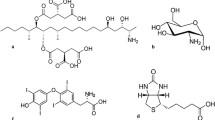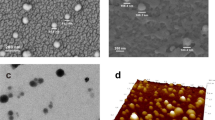Abstract
LIGAND-BINDING assays are used for determination of minute amounts of substances in the bloodstream. Such assays require a receptor that specifically binds the substance of interest. The receptor used is often an antibody1–5, but antibodies require special handling and a costly production procedure5. We have used molecular imprinting, a method for creating selective recognition sites in synthetic polymers6–8, to prepare polymers that mimic antibody combining sites. Molecular imprints made against theophylline9 and diazepam10 showed strong binding and cross-reactivity profiles similar to those of antibodies. Here we describe a new radiolabelled ligand-binding assay, the molecularly im-printed sorbent assay, which uses antibody mimics. This assay accurately measures drug levels in human serum, with results comparable to those obtained using a well established immunoassay technique. Antibody mimics, which are stable and readily prepared by molecular imprinting, may provide a useful general alternative to antibodies.
Similar content being viewed by others
References
Yalow, R. S. & Berson, S. A. Nature 184, 1648–1649 (1959).
Köhler, G. & Milstein, C. Nature 256, 495–497 (1975).
Oellerich, M. J. clin. Chem. clin. Biochem. 22, 895–904 (1984).
Gosling, J. P. Clin. Chem. 36, 1408–1427 (1990).
Kurstak, E. in Enzyme Immunodiagnosis (ed. Kurstak, E.) 5–11 (Academic, London, 1986).
Sellergren, B., Ekberg, B. & Mosbach, K. J. Chromatogr. 347, 1–10 (1985).
Wulff, G. Am. chem. Soc. Symp. Series 308, 186–230 (1986).
Shea, K. J. & Sasaki, D. Y. J. Am. chem. Soc. 113, 4109–4120 (1991).
Hendeles, L., Weinberger, M. & Johnson, G. Clin. Pharmacokinet. 3, 294–312 (1978).
Harvey, S. L. in The Pharmacological Basis of Therapeutics (eds Gilman, A. G., Goodman, L. S., Rall, T. W. & Murad, F.) 339–351 (Dekker, New York, 1985).
Ekberg, B. & Mosbach, K. Trends Biotechnol. 7, 92–96 (1989).
Sellergren, B., Lepistö, M. & Mosbach, K. J. Am. chem. Soc. 110, 5853–5860 (1988).
O'Shannessy, D. J., Ekberg, B., Andersson, L. I. & Mosbach, K. J. Chromatogr. 470, 391–399 (1989).
Andersson, L. I. & Mosbach, K. J. Chromatogr. 516, 313–322 (1990).
Wulff, G. & Minarik, M. J. Iiq. Chromatogr. 13, 2987–3000 (1990).
Fischer, L., Müller, R., Ekberg, B. & Mosbach, K. J. Am. chem. Soc. 113, 9358–9360 (1991).
Andersson, L. I. thesis, Lund Univ. (1991).
Meffin, P. J. & Miners, J. O. in Progress in Drug Metabolism Vol. 4 (eds Bridges, J. W. & Chasseaud, L. F.) 261–307 (Wiley, London, 1980).
Peng, G. W., Gadalla, M. A. F. & Chiou, W. L. Clin. Chem. 24, 357–361 (1978).
Mura, P., Piriou, A., Fraillon, P., Papet, Y. & Reiss, D. J. Chromatogr. 416, 303–310 (1987).
Castro, A., Ibanez, J., Voight, W., Noto, T. & Malkus, H. Clin. Chem. 24, 944–946 (1978).
Chang, J., Gotcher, S. & Gushaw, J. B. Clin. Chem. 28, 361–367 (1982).
Poncelet, S. M. et al. J. Immunoassay, 11, 77–88 (1990).
Baselt, R. C. in Advances in Analytical Toxicology Vol. 1 (ed. Baselt, R. C.) 81–123 (Biomedical, Foster City, CA, 1984).
Altunkaya, D. & Smith, R. N. Forensic Sci. Int. 39, 23–37 (1988).
Dietzler, D. N. et al. Clin. chim. Acta 101, 163–181 (1980).
Cram, D. J. Nature 356, 29–36 (1992).
Rebek, J. Jr. Angew. chem. int. Ed. engl. 29, 245–255 (1990).
Deslongchamps, G., Galán, A., de Mendoza, J. & Rebek, J. Jr Angew. chem. int. Ed. Engl. 31, 61–63 (1992).
Tijssen, P. Laboratory Techniques in Biochemistry and Molecular Biology, Practice and Theory of Enzyme Immunoassays 5th printing (Elsevier, Amsterdam, 1988).
Author information
Authors and Affiliations
Rights and permissions
About this article
Cite this article
Vlatakis, G., Andersson, L., Müller, R. et al. Drug assay using antibody mimics made by molecular imprinting. Nature 361, 645–647 (1993). https://doi.org/10.1038/361645a0
Received:
Accepted:
Issue Date:
DOI: https://doi.org/10.1038/361645a0
- Springer Nature Limited
This article is cited by
-
Synthesis of Innovative Series of MIPs using Acrylic Acid and Diallyl Dimethylammonium Chloride for Adsorption and Environmental Assessment of Chlordiazepoxide
Journal of Polymers and the Environment (2023)
-
Control of the molecular permeability of polysaccharide composite films utilizing a molecular imprinting approach
Polymer Journal (2022)
-
Influence of design and material characteristics on 3D printed flow-cells for heat transfer-based analytical devices
Microchimica Acta (2022)
-
Probing low-copy-number proteins in single living cells using single-cell plasmonic immunosandwich assays
Nature Protocols (2021)
-
Carbon dots-embedded N-acetylneuraminic acid and glucuronic acid-imprinted polymers for targeting and imaging of cancer cells
Microchimica Acta (2021)





